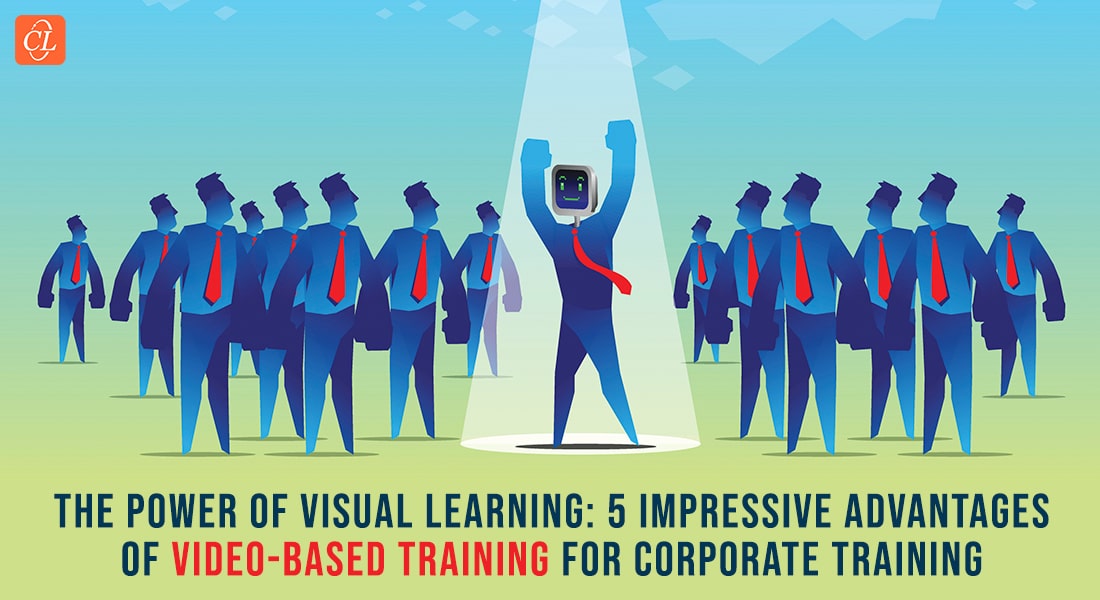5 Spotlight-worthy Benefits of Video-based Learning in Corporate Training

Video-based learning is like being a detective in a mystery movie. Just like how detectives rely on visual clues to solve a crime, learners can use videos to piece together new information and understand complex concepts. The visuals, audio, and dynamic pace of videos make the learning experience more engaging and memorable, bringing lessons to life like never before. So buckle up and get ready to crack the case of facilitating effective and engaging training, with video-based learning as your trusty sidekick.
Leverage Video-based Learning to Elevate Your Corporate Training!
Here are the top 5 benefits to support the statement:
- Improves engagement and interactivity
- Enhances information retention
- Offers flexibility
- Ensures cost-effectiveness
- Caters to different learning styles
As you embark on the journey of corporate training with video-based learning, you find that it provides the perfect balance of structure and creativity. But that’s not all! Therefore, grab your magnifying glass as we explore the top 5 benefits of video-based learning.
Are you ready?
Let’s roll!
5 Spotlight-worthy Benefits of Video-based Learning in Corporate Training
The benefits of video-based learning are numerous and varied. But here I’ll be talking about the major 5 ones in detail.
Improves Engagement and Interactivity
Boring or interesting? Well, even without the context specified, I’m sure you would have opted for the latter one. And why not? After all, interesting in its simple sense, is something that captivates attention, initiates participation, and at times offers motivation to keep going. Learning is also very similar. With that said, video-based learning is great for improving engagement and interactivity among learners because it’s just so darn interesting!
It is much more engaging than traditional training methods, such as reading text or simply listening to audio lectures. With the use of visuals, animations, and interactive elements, it holds learners’ attention, thereby making training feel less like work and more like entertainment. Moreover, it promotes interactivity as it leverages quizzes, polls, and other immersive elements, which help employees apply what they have learned and test their understanding. Well, there’s more.
Check out these impressive 116 eLearning design and development tips to uplift your training material.
Enhances Information Retention
The multi-sensory nature of video-based learning makes it easier for learners to retain information. The idea behind the statement is that learning through multiple senses can have a more profound and lasting impact on the learner’s memory compared to learning through a single sense. It combines visual and auditory elements, which enhance learner engagement with the content and helps them to better understand complex concepts and retain the acquired information for longer periods of time. The visual elements include images, graphics, icons, fonts, diagrams, etc., and the audio components consist of narration, background music, sound effects, etc. This technique is highly effective in boosting information retention and reinforcement.
Offers Flexibility
In today’s fast-moving world, multitasking has become the new norm. Time has become a precious entity and people are trying to get the most out of every moment possible. Your employees, or to be precise the learners in the training scenario are no different. And to help them make the best of their time, video-based learning facilitates a more convenient, flexible approach that enables the learners to access eLearning courses at any time, from anywhere.
This ensures that employees complete the training at a time and place that suits them, making it ideal for busy schedules and remote workforce. Even better, it augments their understanding as they can adjust the pace of learning and revisit the concepts according to their requirement.
Ensures Cost-effectiveness
Video-based learning is a fantastic solution that assures cost-effectiveness in corporate training. That’s right! It outright eliminates the need for budget-heavy components of training and ensures more cost-effective, high-quality content for corporate training. If you’re wondering how is that possible and what are the elements that add to the expense.
Well, in video-based learning there is no accommodation cost, no printing material cost, no trainer fee, and no traveling cost. In fact, creating and distributing video-based learning material is more simple and more pocket-friendly than classroom training. Therefore, it is an ideal choice for your training ventures when you’re planning to train large numbers of employees without breaking the bank.
Caters to Different Learning Styles
One size doesn’t fit all. This is true in general and particularly relevant when it comes to learning styles in corporate training. Every employee has their own set of strengths and shortcomings. Therefore, generalizing the training approach does more harm than good. To ensure that your employees make the best of the training provided, it is important to consider their unique learning styles and interests.
Video-based learning is adept and a great option for accommodating different learning styles as it offers a multi-sensory experience that caters to visual, auditory, and kinesthetic learners.
From a wealth of visuals to immersive interactivities to high-quality audio, it ensures a comprehensive learning package. So regardless of your employees’ learning habits and styles, video-based learning is sure to fulfill the desired purpose of facilitating an effective, learner-centric eLearning course.
To Sum It Up!
Video-based learning has reformed the way corporate training is conducted today. With a plethora of benefits, it has emerged as a preferred mode of training in the corporate world. The interactive and engaging nature of video-based training has made it easier for employees to grasp complex concepts, retain information, and apply their newfound knowledge in the workplace.
The future of corporate training lies in the hands of video-based learning, and companies that embrace this innovative approach are sure to reap the benefits of a well-informed, motivated, and skilled workforce. But designing effective video-based learning content is not easy. So check out this eBook containing competent instructional design strategies to help you put your best foot forward.




![5 Reasons to Choose Video-Based Learning for Sales Training [Infographic]](https://blog.commlabindia.com/hubfs/blogs/reasons-choose-video-based-learning-sales-training-info.jpg)
